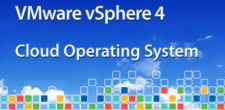 VMware vSphere is an industry leading virtualization platform. Basically it is a software suite composed of applications directed towards managing datacenters through the use of virtualization technology. I’m going to briefly discuss some of the major/core components of vSphere 4. This will give you a clear idea of some of the power behind vSphere 4 and virtualization technology in general. For more information/documentation and a full list of benefits offered by vSphere 4, you should check VMware’s website.
VMware vSphere is an industry leading virtualization platform. Basically it is a software suite composed of applications directed towards managing datacenters through the use of virtualization technology. I’m going to briefly discuss some of the major/core components of vSphere 4. This will give you a clear idea of some of the power behind vSphere 4 and virtualization technology in general. For more information/documentation and a full list of benefits offered by vSphere 4, you should check VMware’s website.
The two main components of VMware vSphere 4 are ESXi Server and VirtualCenter. ESXi is the host machine or hypervisor that virtual machines (VMs) are installed on; I have written previous blogs about ESXi (see The Power of Virtualization – a competitive edge and Using the VI Java API with VMware ESXi). You can use ESXi as a standalone server with virtual machines running on it as well as take advantage of Virtual Symmetric Multi-Processing (SMP). Virtual SMP allows VMs to have up to eight virtual CPUs (vCPUs); this helps boost performance of resource intensive applications. However, for added functionality and enterprise level virtualization you will need VirtualCenter. VirtualCenter has some very powerful components for enterprise level virtualization. I discuss these in more detail below:
VMware VMotion – this is a truly impressive technology which allows virtual machines to be moved from one ESXi host to another while the VM is still running and with no impact to end users. You can think of it as a live migration. If the server is running low on resources or needs to be taken down, simpy VMotion your VM to another server with no down time!
Storage VMotion – VMotion moves the logical representation of a machine from one host to another while the files that make up the VM remain on the shared disk; Storage VMotion moves the files that make up the VM from shared storage to local storage or from one shared storage to another shared storage.
Distributed Resource Scheduler (DRS) – does dynamic resource load balancing across ESXi hosts. For example, it will move one VM to another less resource-strained ESXi host to balance resource capacity across all ESXi hosts. Think about it – you can just add more ESXi hosts and VMware DRS will take care of everything for you and simply move VMs as needed to the least resource-strained host. And remember, all this is done without the VM going offline; users are never affected. You can truly see the foundation of a cloud computing platform here.
High Availability (HA) – if an ESXi host running VMs goes down, the affected VMs will be restarted on another ESXi host. This is possible because both ESXi hosts can see the same shared storage and they both have access to the same virtual machine files. It is important to remember, in this case, there will be a short down time until the VMs come back up, but your Service Level Agreements (SLAs) will definitely be positively affected.
Consolidated Backup – a framework that allows third party tools to backup virtual machines.
Fault Tolerance (FT) – a method in which two VMs are constantly in sync with each other on two separate hosts. Actually, there is no synching done, but rather the two VMs behave as mirrors to each other in which case whatever is done to one VM is done to the other at the exact same time. If one host fails, the other host will pickup with no gap in service or loss in connectivity! This is a new feature in vSphere 4 and surely out-does HA since there is no loss of service/connectivity.
Hot Add – allows you to add memory, CPU, HDD, etc.. to a VM without bringing it down.
Thin Provisioning – eliminates unnecessary waste of storage by allocating space to a VM on an as needed basis. You can allocate more storage than you actually have because that space is never committed until you need it. I can’t tell you how many times on OS installs I’ve allocated more space than I needed or not allocated enough space.
VMDirectPath – allows you to attach a PCI device directly into the VM. No more excuses that VMs can’t handle IO intensive applications! One of the downfalls of VMDirectPath is that if you attach a PCI device into a VM, you won’t be able to VMotion that VM.
vNetwork Distributed Switch – a centralized virtual switch that spans across multiple hosts. The traditional vSwitch is managed on a per host basis. vNetwork Distributed Switch provides consolidation to prevent redundancy when applying configurations. It is a centralized switch which each ESXi host can be a member of. Now, you can apply a configuration on one virtual switch that works across all ESXi hosts!
Cisco Nexus 1000V – a 3rd party vNetwork Distributed Switch. It runs the Cisco NX-OS and extends features like QoS, private VLANS, access control lists, NETFLOW, and SPAN to VMs. You can think of it as an enhancement to vNetwork Distributed Switch; of course, it has a Cisco tie-in which may be a win-win for you if you already have Cisco gear.
vShield Zones – allows you to create virtual firewalls and monitor and manage traffic across your virtual network.
vCenter Orchestrator – automation engine which enables you to organize workflows and run them at specific intervals.



 Twitter
Twitter LinkedIn
LinkedIn Youtube
Youtube RSS
RSS